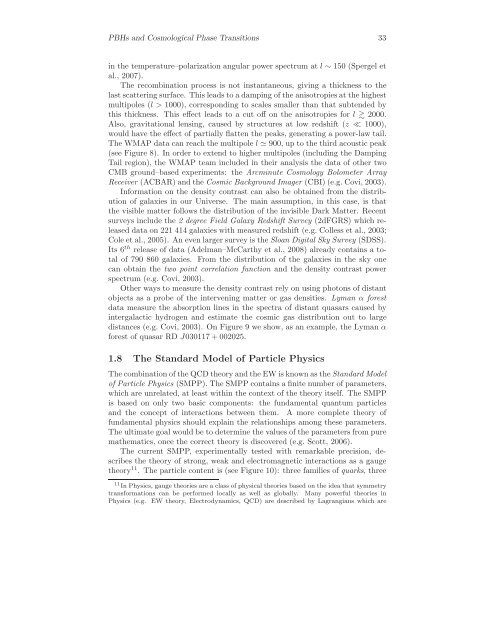Primordial Black Holes and Cosmological Phase Transitions Report ...
Primordial Black Holes and Cosmological Phase Transitions Report ...
Primordial Black Holes and Cosmological Phase Transitions Report ...
Create successful ePaper yourself
Turn your PDF publications into a flip-book with our unique Google optimized e-Paper software.
PBHs <strong>and</strong> <strong>Cosmological</strong> <strong>Phase</strong> <strong>Transitions</strong> 33<br />
in the temperature–polarization angular power spectrum at l ∼ 150 (Spergel et<br />
al., 2007).<br />
The recombination process is not instantaneous, giving a thickness to the<br />
last scattering surface. This leads to a damping of the anisotropies at the highest<br />
multipoles (l >1000), corresponding to scales smaller than that subtended by<br />
this thickness. This effect leads to a cut off on the anisotropies for l 2000.<br />
Also, gravitational lensing, caused by structures at low redshift (z ≪ 1000),<br />
would have the effect of partially flatten the peaks, generating a power-law tail.<br />
The WMAP data can reach the multipole l 900, up to the third acoustic peak<br />
(see Figure 8). In order to extend to higher multipoles (including the Damping<br />
Tail region), the WMAP team included in their analysis the data of other two<br />
CMB ground–based experiments: the Arcminute Cosmology Bolometer Array<br />
Receiver (ACBAR) <strong>and</strong> the Cosmic Background Imager (CBI) (e.g. Covi, 2003).<br />
Information on the density contrast can also be obtained from the distribution<br />
of galaxies in our Universe. The main assumption, in this case, is that<br />
the visible matter follows the distribution of the invisible Dark Matter. Recent<br />
surveys include the 2 degree Field Galaxy Redshift Survey (2dFGRS) which released<br />
data on 221 414 galaxies with measured redshift (e.g. Colless et al., 2003;<br />
Cole et al., 2005). An even larger survey is the Sloan Digital Sky Survey (SDSS).<br />
Its 6 th release of data (Adelman–McCarthy et al., 2008) already contains a total<br />
of 790 860 galaxies. From the distribution of the galaxies in the sky one<br />
can obtain the two point correlation function <strong>and</strong> the density contrast power<br />
spectrum (e.g. Covi, 2003).<br />
Other ways to measure the density contrast rely on using photons of distant<br />
objects as a probe of the intervening matter or gas densities. Lyman α forest<br />
data measure the absorption lines in the spectra of distant quasars caused by<br />
intergalactic hydrogen <strong>and</strong> estimate the cosmic gas distribution out to large<br />
distances (e.g. Covi, 2003). On Figure 9 we show, as an example, the Lyman α<br />
forest of quasar RD J030117 + 002025.<br />
1.8 The St<strong>and</strong>ard Model of Particle Physics<br />
The combination of the QCD theory <strong>and</strong> the EW is known as the St<strong>and</strong>ard Model<br />
of Particle Physics (SMPP). The SMPP contains a finite number of parameters,<br />
which are unrelated, at least within the context of the theory itself. The SMPP<br />
is based on only two basic components: the fundamental quantum particles<br />
<strong>and</strong> the concept of interactions between them. A more complete theory of<br />
fundamental physics should explain the relationships among these parameters.<br />
The ultimate goal would be to determine the values of the parameters from pure<br />
mathematics, once the correct theory is discovered (e.g. Scott, 2006).<br />
The current SMPP, experimentally tested with remarkable precision, describes<br />
the theory of strong, weak <strong>and</strong> electromagnetic interactions as a gauge<br />
theory 11 . The particle content is (see Figure 10): three families of quarks, three<br />
11 In Physics, gauge theories are a class of physical theories based on the idea that symmetry<br />
transformations can be performed locally as well as globally. Many powerful theories in<br />
Physics (e.g. EW theory, Electrodynamics, QCD) are described by Lagrangians which are
















